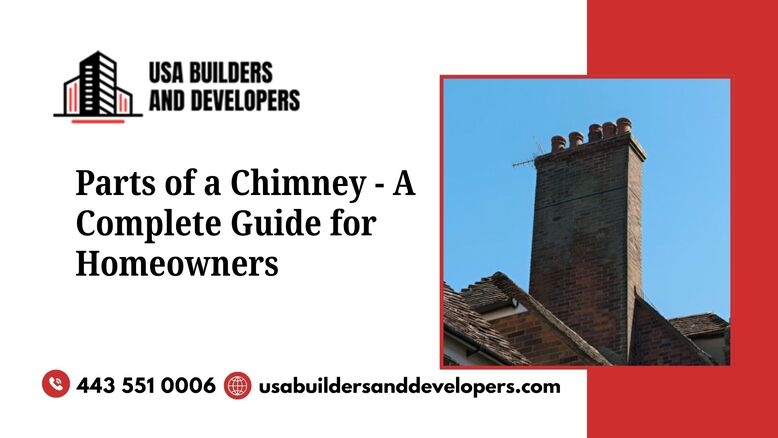A chimney might seem like a simple structure, but it’s made up of several key parts that work together to keep your home safe and smoke-free. Whether you’re using a wood-burning fireplace or a furnace, understanding the parts of a chimney helps you spot potential issues early, before they become expensive problems.
In this guide, we’ll break down each component, explain its role, and show how professional chimney repair and inspection can extend the life of your entire system. At USA Builders and Developers, we also provide expert masonry services, including reliable chimney repair, to help protect your home for years to come.
Why Understanding Chimney Parts Matters
Knowing how your chimney works isn’t just for contractors. It helps you:
- Spot potential problems early
- Save money on repairs
- Communicate clearly with professionals
- Keep your home safe and energy-efficient
If your chimney is damaged or poorly maintained, it can lead to serious risks like house fires, carbon monoxide buildup, and water damage.
Main Parts of a Chimney Explained
Here’s a detailed look at the most important parts of a chimney:
1. Chimney Cap
The chimney cap sits on top of the flue and prevents rain, debris, and animals from entering the chimneys. It’s usually made of stainless steel or copper.
Why it matters:
It helps protect the interior of your chimneys from water damage and blockages.
2. Chimney Crown
Often confused with the cap, the chimney crown is a slab of concrete or mortar that seals the top of the chimneys structure.
Why it matters:
It directs water away from the flue to prevent leaks and masonry damage.
3. Flue Liner
The flue liner is a heat-resistant layer inside the chimney that guides smoke and gases safely out of the home.
Why it matters:
It protects the walls of your chimney and helps prevent fires.
4. Chimney Flue
This is the actual passage inside the chimney that allows smoke to exit the home. It’s typically lined with clay tile, metal, or ceramic.
Why it matters:
A clean, functioning flue ensures proper ventilation and fire safety.
5. Chimney Pipe
The chimney pipe is the metal tube that runs vertically inside your chimney system. It carries smoke and gases from your fireplace or stove to the outside. These pipes are often used in metal or prefab chimneys and wood stove installations.
What it does:
- Safely moves hot smoke and gases out of your home.
- Reduces fire risk by containing heat inside the pipe.
- Works alongside insulation and covers to protect your structure.
6. Damper
The damper is a movable metal plate that opens and closes the flue.
Why it matters:
You can control airflow—open it when using the fireplace and close it when not in use to save energy.
7. Firebox
The firebox is where the fire burns. It’s made from fireproof bricks or materials.
Why it matters:
This is the area that takes the most heat, so it needs to stay in good condition for safety.
8. Ash Dump (if present)
Some fireplaces include an ash dump—a small door or compartment below the firebox.
Why it matters:
It provides a simple way to remove ash without making a mess.
Table: Parts of a Chimney and Their Function
| Chimney Part | Function | Potential Issue if Damaged |
|---|---|---|
| Chimney Cap | Keeps out water, animals, and debris | Water leaks, bird nests, downdrafts |
| Chimney Crown | Seals top of chimney structure | Cracking, moisture damage |
| Flue | Exhausts smoke and gases | Gas leakage, fire risk |
| Damper | Controls air flow and draft | Smoke backflow, energy loss |
| Smoke Chamber | Funnels smoke into flue | Poor draft, smoke spillage |
| Firebox | Holds and contains the fire | Heat damage to walls, fire risk |
| Ash Dump/Ash Pit | Collects ashes for easy disposal | Blockage, inefficient burning |
| Cleanout Door | Allows removal of ash and soot | Draft issues, pest entry if left open |
Common Problems with Chimney Parts
Understanding the parts of a chimney helps you spot problems before they become expensive:
- Cracks in the crown can cause leaks
- Missing chimney cap leads to moisture, nesting birds, and blockages
- Damaged flue liner increases fire and carbon monoxide risks
- Rusty damper affects airflow and efficiency
- Loose bricks or mortar (spalling) are signs of moisture damage
Regular inspections and masonry services can catch these issues early and keep your chimney functioning safely.
Professional Chimney Inspection and Repair
At USA Builders and Developers, we specialize in inspecting, repairing, and restoring all parts of flue. Our certified team ensures your chimneys is functioning safely and efficiently, whether you need a new chimney cap or a full flue liner replacement.
With decades of experience, we serve both residential and commercial properties across Maryland with trusted masonry services. We follow all safety codes and offer modern solutions without compromising traditional craftsmanship.
FAQs About parts of chimney
What are the main parts of chimney?
What is the purpose of a chimney flue?
What does a chimney cap do?
Why is chimney flashing important?
Final Thoughts
Understanding the parts of chimney isn’t just for contractors, homeowners can benefit too. From the chimney cap to the firebox, each part plays a vital role in keeping your home safe, warm, and efficient. Learning how these parts work together can help you recognize warning signs, ask the right questions, and keep your chimneys in good shape year-round.
Have Questions? Call Us Now!
We’re here to help—quick answers, friendly service, anytime you need!

